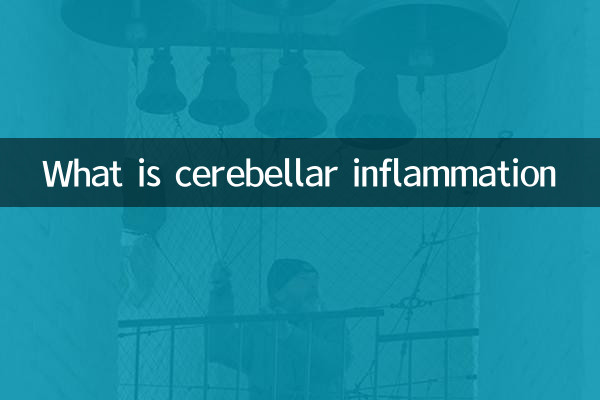What is cerebellar inflammation
Cerebellar inflammation is a rare but severe neurological disease that is usually caused by infection, autoimmune reaction, or other causes. As an important part of the brain, the cerebellum is responsible for coordinating movement, balance and language functions. Once inflamed, it can lead to a series of movement disorders and cognitive problems. In recent years, with the deepening of medical research, significant progress has been made in the diagnosis and treatment of cerebellar inflammation. This article will combine popular topics and hot contents across the network for the past 10 days to introduce you in detail the causes, symptoms, diagnosis and treatment methods of cerebellar inflammation.
1. Causes of cerebellar inflammation

The causes of cerebellar inflammation are diverse, mainly including the following categories:
| Type of cause | Specific instructions |
|---|---|
| Viral infection | Such as herpes virus, influenza virus, etc., may cause cerebellar inflammation. |
| Bacterial infection | Bacterial infections such as streptococci and tuberculosis may also lead to inflammation of the cerebellum. |
| Autoimmune diseases | Such as multiple sclerosis, autoimmune encephalitis, etc. |
| Drugs or toxins | Certain drugs or chemicals may cause damage to the cerebellum. |
| Other reasons | Such as tumors, trauma or genetic factors. |
2. Symptoms of cerebellar inflammation
The clinical manifestations of cerebellar inflammation vary, and the specific symptoms depend on the severity and scope of the inflammation. The following are common symptoms:
| Symptom Types | Specific performance |
|---|---|
| Movement disorders | Unstable walking, poor physical coordination, tremor, etc. |
| Language barriers | Speak vaguely, speak slowly, or repeat syllables. |
| Balance issues | Dizzy, difficulty standing or sitting. |
| Cognitive function decline | Inattention and memory loss. |
| Other symptoms | Headache, nausea, vomiting, etc. |
3. Diagnosis of cerebellar inflammation
Diagnosing cerebellar inflammation requires combining clinical manifestations and medical examinations. The following are common diagnostic methods:
| Diagnostic method | Specific instructions |
|---|---|
| Neurological examination | Assess movement, balance and language function. |
| Imaging examination | MRI or CT scans can observe changes in the cerebellar structure. |
| Cerebrospinal fluid examination | The inflammatory markers in cerebrospinal fluid were analyzed by lumbar puncture. |
| Blood test | Indicators for detecting infection or autoimmune disease. |
| Other checks | Such as electroencephalography (EEG), etc. |
4. Treatment of cerebellar inflammation
The treatment of cerebellar inflammation requires a personalized plan based on the cause. The following are common treatment methods:
| Treatment method | Specific instructions |
|---|---|
| Anti-infection treatment | Use antibiotics or antiviral drugs for viral or bacterial infections. |
| Immunomodulation therapy | Such as using glucocorticoids or immunosuppressants. |
| Symptom-based treatment | Such as antiemetics, painkillers, etc. to relieve symptoms. |
| Rehabilitation treatment | Physical therapy, language training and other functions help restore. |
| Surgical treatment | Surgery is only required in rare cases, such as tumor compression. |
5. Related discussions on recent hot topics and cerebellar inflammation
In the past 10 days, the discussion on cerebellar inflammation across the Internet has mainly focused on the following aspects:
| Hot Topics | Discussion content |
|---|---|
| Sequelae of COVID-19 | Some patients reported abnormal cerebellar function, which may be related to viral infection. |
| Autoimmune encephalitis | The medical community pays attention to cerebellar inflammation caused by autoimmune diseases. |
| Rehabilitation cases | Several patients recovered their motor function through comprehensive treatment. |
| New drug development | Targeted drugs for cerebellar inflammation have entered the clinical trial stage. |
6. Summary
Cerebellar inflammation is a complex neurological disease with diverse causes and symptoms. Early diagnosis and targeted treatment are crucial to improve prognosis. With the advancement of medical research, more and more treatments bring hope to patients. If you or your family have relevant symptoms, please seek medical treatment in time to avoid delaying the condition.
This article combines recent hot topics to provide you with a comprehensive interpretation of cerebellar inflammation. For further information, please pay attention to the authoritative information of professional medical institutions.

check the details

check the details